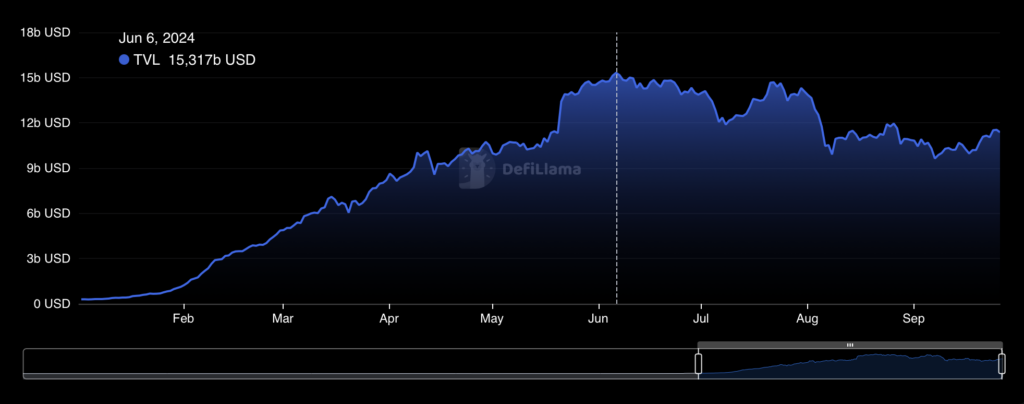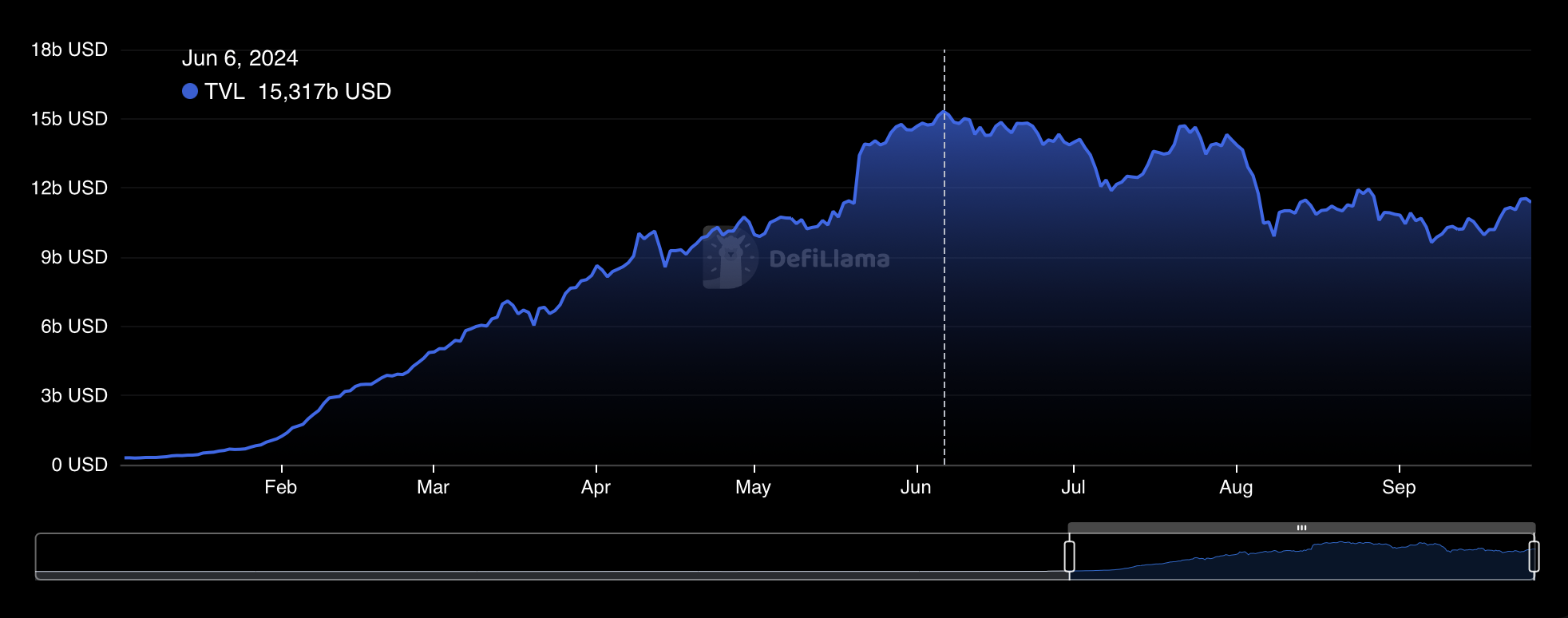
The DeFi space is expanding, with liquid staking and restaking protocols gaining more and more attention. These developments allow users to stake and reuse assets multiple times, offering the potential for higher yields. However, as these systems become more complex, they also introduce potential systemic vulnerabilities.
Projects like EigenLayer are pushing the limits of yield maximization, but are these returns sustainable? The question remains whether these innovations are setting DeFi up for lasting success or creating the next wave of risks.
The Growing Influence
Restaking protocols, led by platforms like EigenLayer, have become a major force in the decentralized finance (DeFi) sector. Restaking refers to the process where users take assets staked on one protocol, such as Ethereum’s liquid staking tokens (LSTs), and stake them again on another platform to earn additional yields.
This process has unlocked significant earning potential, driving restaking’s rise. In 2024, liquid restaking tokens (LRTs) saw an enormous 4,900% growth in Total Value Locked (TVL), surpassing $15 billion from a mere $280 million in early 2024.
“The push for higher yields is a key to keeping staking attractive, especially as the total amount of ETH staked on the Beacon Chain grows and the average APY (annual percentage yield) declines. This is one of the main reasons DeFi and restaking protocols have been so well-received,” Alon Muroch, CEO and Founder at SSV.Labs, told BeInCrypto in an exclusive interview.
Read more: Ethereum Restaking: What Is it and How Does it Work?

Restaking protocols offer users opportunities to maximize returns on their staked assets without having to sacrifice liquidity. However, as restaking scales, concerns about liquidity and security risks are emerging.
“Each additional layer in restaking increases both risk and reward, making it a choice that users must make based on their risk tolerance. While it introduces more potential points of failure, it also opens up opportunities for significantly greater returns. Ultimately, the user has the freedom to decide the level of exposure they are comfortable with,” Muroch added.
Balancing the Promise and Peril of Restaking
Although the ability to re-use staked assets has been celebrated as an innovation, it simultaneously introduces new layers of exposure. In essence, restaking involves leveraging staked assets across different protocols, which may sound appealing for yield optimization, but it creates systemic vulnerabilities.
Muroch identified several main problems associated with restaking:
- Smart Contract Vulnerabilities. The complexity of restaking mechanisms increases the potential for bugs and exploits in the smart contracts governing these protocols. Users may lose funds if a contract is compromised.
- Complexity and Lack of Understanding. As restaking strategies become more complex, there is a risk that users may not fully understand the risks they are taking on. Some Actively Validated Services (AVSs) have higher risk than others due to more/complex slashing criteria for different AVSs.
- Slashing Risks. If a validator is found guilty of malicious behavior, a portion of their restaked ETH can be slashed. This risk is compounded because node operators are subject to slashing conditions for both the Ethereum base layer and any additional AVSs.
Moreover, the financial architecture behind restaking has left DeFi exposed to potential liquidity drains. For example, EigenLayer’s current restaking system allows users to restake liquid staking tokens (LSTs) multiple times, amplifying liquidity challenges. These risks were evident in the Ankr exploit, where a hacker minted 6 quadrillion fake aBNBc tokens, crashing the price of liquid staking derivatives across various protocols.
The unclear regulatory frameworks add to the complexity of restaking. Muroch cautions that regulators will likely take a cautious approach to restaking, seeing it as distinct from traditional staking because of its added layers of risk and complexity. They may impose stricter regulations to protect investors and ensure the stability of the financial ecosystem as these protocols gain traction.
The Threat of Over-Restaking
EigenLayer, one of the biggest restaking protocols, has garnered over $19 billion in TVL by mid-2024. While this impressive expansion demonstrates the market’s appetite for higher yields, it raises questions about the sustainability of these protocols.
The dominance of EigenLayer also poses a unique threat to Ethereum’s overall security. Since these restaking platforms are handling large quantities of staked ETH, any major failure could directly impact Ethereum’s security model.
Experts, including Ethereum co-founder Vitalik Buterin, have voiced concerns that if a restaking protocol failed, it could lead to calls for a hard fork of Ethereum to “undo” the damage, an outcome that threatens the network’s decentralized consensus.
Read more: How to Participate in an EigenLayer Airdrop: A Step-by-Step Guide

Muroch, however, downplayed the severity of the situation, describing it as “theoretically bad, but practically quite unlikely.”
“If a significant amount of Ether is locked in EigenLayer and a large operator suffers a major slashing event, it could lead to a cascade of slashing damage. In a worst-case scenario, this could compromise the extended security of the Ethereum network. However, it would take the slashed operator not fixing the problem for a long period of time for Ethereum’s security to be threatened,” he explained.
He also highlighted an important upside, noting that restaking raises the cost of corruption for potential attackers. This shift strengthens security by focusing not just on individual protocols but on the total sum of all staked assets.
Hidden Dangers of Yield Optimization
The pursuit of higher yields has led stakers to adopt increasingly complex strategies, which carries both financial and technical risks. Financially, restaking protocols encourage users to stake their assets across multiple platforms, tying up more capital in interconnected systems. This raises systemic financial risks, as vulnerabilities in one protocol could trigger broader consequences across the ecosystem.
Muroch cautions that restaking is still a relatively new concept, making it difficult to predict its long-term effects. The potential for unforeseen issues, especially in volatile markets, adds uncertainty to the future of these strategies.
“Staking rewards have only recently been introduced, meaning it will take some time to fully understand their long-term effects. As always, there are ‘unknown unknowns’ that could arise. In the future, if the value of restaked assets were to drop sharply, the heavy reliance on rehypothecation and complex financial derivatives could trigger a liquidity crisis,” he said.
This would likely cause users to liquidate their positions en masse, worsening market volatility. In such a case, confidence in the underlying protocols might erode further, potentially causing widespread destabilization in the DeFi space.
“At this point it’s really speculative. Looking back to the past in DeFi, trying to milk yields as hard as possible tends to end badly,” Muroch warned.
Ultimately, the success of restaking protocols hinges on their ability to balance maximizing yields with managing the inherent financial and technical risks they introduce. As these systems mature, the sector is beginning to diversify. New competitors are launching their own restaking solutions, which could help decentralize risk currently concentrated in platforms like EigenLayer.
This shift may reduce the systemic vulnerabilities tied to one dominant protocol, leading to a more stable and resilient DeFi ecosystem over time.
“As excitement wanes, the sustainability of these protocols will be tested, and their true value will need to be assessed in a more stable market environment. This transition could reveal whether the innovations are robust or merely speculative trends,” Muroch concluded.
The post DeFi in Crisis: Restaking Protocols Are Devouring Liquidity appeared first on BeInCrypto.



:max_bytes(150000):strip_icc()/Bitcoin-7c580bcd389d4aef8f5a7bdb42cd26bb.jpg)

